The
Northrop F-5 Enthusiast Page - Home
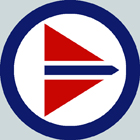
Luftvorsvaret - Air Force
Credit: Roundels of the world
Last update 18-05-2020
Procurement and use
Beginning 1960's Norway
needed to consider replacement of its ageing North American
F-86F and North
American/Fiat F-86K. Being only able to count with a reduced US
financial
help to buy new aircrafts
it was decided to select a new aircraft for the
fighter-bomber role, paying
for a part of them; shortlisted were the Douglas A-4E Skyhawk, the Fiat G-91, the
Lockheed
F-104H Starfighter and the Freedom Fughter
The a merican aircrafts were tested ine USA between
September
and October 1963 by a Norwegian AF team.
A special
version of the F-5, without
guns, fitted with extra fuel cells and infra-red or missile guided
air-to-air missiles, was initially taken into consideration. Standard
configuration, plus JATO provision, windscreen
de-icing and arrester
hook, was actually
selected due to the high cost of the modifications; in addition they were to be the only Freedom Fighters capable of firing AGM-12 Bullup missiles. The selection of the
Northrop F-5 was announced on 28-02-64
with the order for
64 aircrafts (56 F-5A(G)
fighter-bombers, 8
F-5B(G) trainers) to
equip 3 Squadrons each of 20 aircrafts plus 4 reserves for attrition.
The estimated
cost was 530 millions Norwegian Kroner, Norway paying
approximately 200 millions,
corresponding to 46 aircrafts. This was the first non-USA order for the
aircraft.
The
Norwegian parliament authorised in March 1967 the acquisition of 10 additional Northrop F-5A(G) and 2 F-5B(G); 16 Northrop RF-5A(G)
were finally ordered in February
1968. The
country was the only Eurioean
NATO member to have a border with the
Soviet Union. Reconnaissance was most important due to its border and
long coast.
First Northrop F-5A(G),
serial 64-13368, flew from Edwards AFB on 17-06-65; three
pilots/ground personnel tested
for 250 hours the
newly built aircrafts in USA between June and February 1966.
In-flight
deliveries started in February 1966, 9 Northrop F-5A(G) and 2 Northrop F-5B(G)
arrived
at Sola AS on 26-02-66 after a 5 days/6'300 miles (10'140 km) ferry
flight,
covered in 14 hrs 35 minutes actual
flying time, routing from Edwards
AFB to Sola AB via Kirtland, Langley-Loring, Goose Bay,
Sondrestfjorden, Keflavic, prestwick, McClellan AFB house Northrop
f-5(G) awaiting their delivery,
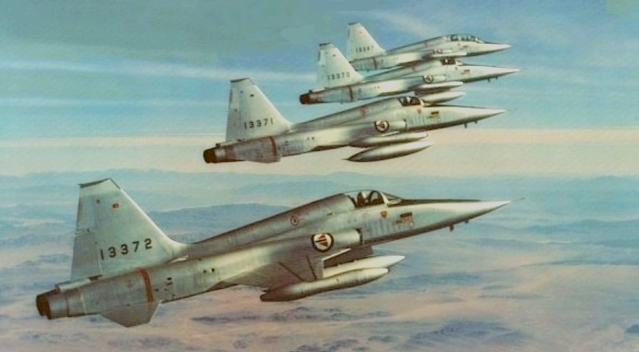 Photo: unknown
Photo: unknown 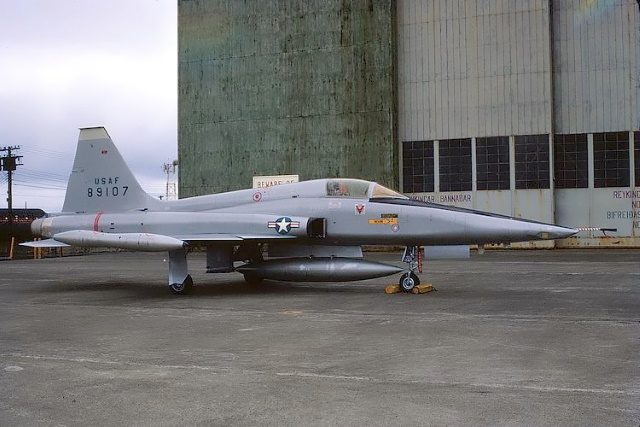
Early photo of Northrop F-5A 13372, 13371, 13373 and F-5B 13387 before delivery February 1966.
Northrop RF-5A 89107, on delivery in USAF markings, 19-09-69 at Keflavik.
hoto: Archive The Northrop F-5 Enthusiast
Initial
plans were to equip 336 Squadron
as
first operational unit with
Northrop F-5A(G) and some F-5B(G), based at Rygge Air Station, followed by 338 Skvadron (at
Orland AS), all flying North American F-86F,
332 Skvadron based at Rygge AS plus 334 Skvadron at Bodø AS, both equipped with all-weather fighter North American/Fiat F-86K, now changing
their role to ground to ground support.
According
to an official US list funding was provided for the Security Assistance Program FY
1976 (or previously) 16 Northrop RF-5A, 31 F-5A.
Additional units were re-equipped with F-5s later: 717 Skvadron with RF-5A(G) at Rygge AS to
replace its Republic RF-84F in the reconnaissance role and Sola AS
based 718 Skvadron (formerly equipped with
Lockheed
T-33A) for the Operational Conversion role in 1968, mainly
with Northrop F-5B(G) plus some F-5A(G). The last Republic RF-84F was retired in June 1970.
Approximately
40 aircrafts were delivered by the end of 1966; all four fighter-bomber units
were re-equipped by 1967, the training unit in 1968, the reconnaissance
unit in 1969. Deliveries were completed by 14-12-70,
comprising 78
Northrop F-5(G), 23 of these funded through the US Military Aid
Program; 16 RF-5A(G); 14 F-5B(G), 8 funded through MAP.
Shortage of personnel and
aircrafts, due to unusal high attrition,
forced to reduce in 1973 the number of Freedom Fighter units: 332
Skvadron was
disbanded (its aircrafts were redistribu-
ted to the other Squadrons), while 334
Squadron was re-equipped with Canadair CF-104. As 16 aircrafts had been lost by
mid-1970s there
were not enough
F-5s to maintain four Squadrons,
even with only 16 operational
aircrafts, number reduced from
20 originally foreseen.
The
Air Force made an exceptional excercise on 17-06-70 when two Northrop
F-5A from 718 Squadron landed and took-off from Kautokeino, a remote,
3'100 gravel strip located within the
Artic Circle. There was no
Foreign Object Damage to the aircrafts. Four bottles for Assisted Take
Off were istalled as a precautionary measure but were used.
This demonstrated the capabilities of the Freedom Fighter to operate from short, unimproved, remote airstip.
AIM-9L Sidewinder missiles
were acquired for the air-to-air role, a
variety of bombs and rocket pods have been used for the air-to-ground
role, while soviet Tu-16 Badgers nearing Nowergian
air space were regularly intercepted.
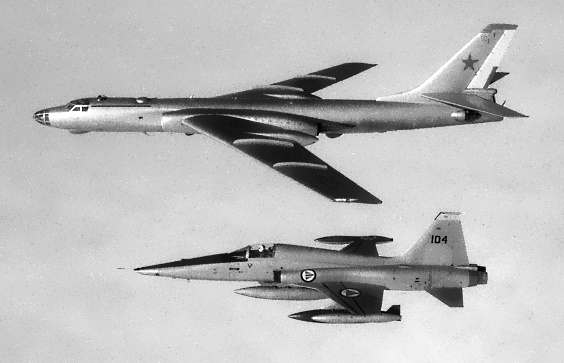 Photo: Tor Helge Yttervik
Photo: Tor Helge Yttervik
Modifications
and updating
Upgrade
was high on the list of modifications to Norwegian Freedom
Fighters making them for a long time some of the best equipped Freedom
Fighters in the world.
A
new Ferranti lead-computing optical sighting system for both gun firing
and missile delivery were fitted already from 1973.
The Freedom Fighters kept the metallic colours as delivered. Two received an experimental camouflage. One (serial 373) was painted
in a dark green like the Canadian CF-104s, and serial 228, probably late 1973. They were also used as "Aggressor" aircrafts
.
 Photo: unknown
Photo: unknown 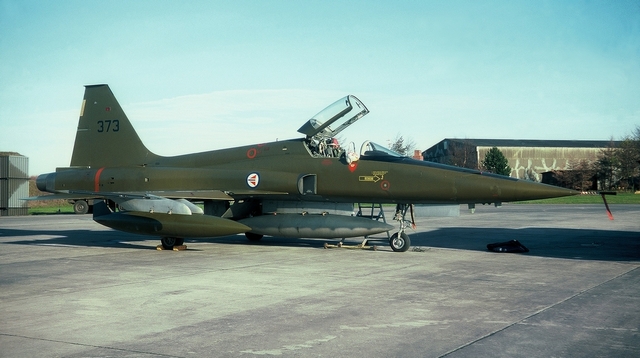
Northrop F-5A 563
, 338 Squadron, in metallic colour with with three digit serial 563 with rocket
Green
camouflaged Northrop F-5A serial 373, 336 Squadron, seen at Husum AB in
November 1976
launcher, seen at
Sola in June 1975.
Photo: F. Willemsen
Photo: Archive The Northrop F-5 Enthusiast
Structural
modifications to the fleet was urgently needed by 1982, when
up to 60% of the fleet had to be grounded due to cracks in
the engine air intake. Norway requested payment of the repairs by the
USA under the original MAP agreement, the charge finally being debited
to the USAF for the single-seaters and to Norway for the double-seaters.
Service
Life Extension Programme (SLEP) for 17 Northrop F-5A and 13
F-5B(G) aircrafts started
in 1984; it included a
corrosion-protection programme, carried out by Fokker in the
Netherlands beginning July 1984 and lasting till the end of October 1986.
This was followed by upgrading in
avionics at the local depot at
Kjeller AB: AN/ALR46 radar warning receiver nose mounted, ALE-38
chaff/flare dispenses (these were later replaced by ALE-40) and others.
Their
foreseen role was limited air-defence with AIM-9L Sidewinder and
Electronic Warfare, active jamming, with podded equipment.
Last aircraft completed under this
programm was rolled out on 03-11-87.
The aircrafts undergoing the
corrosion-protection programme at Fokker received light gray colours as part of the protection
 Photo: Archive The Northrop
F-5 Enthusiast
Photo: Archive The Northrop
F-5 Enthusiast
Northrop F-5A 215 with RWR on tail, chaff dispenser and training
Sidewinder seen in May 1990at Mildenhall .
A big step forward was the installation,
under an USD 20m programme awarded in February 1991, of
further new avionics
equipment by Sierra Technologies Inc to replicate the F-16 cockpit in
use in
Norway, including an GEC-Marconi Head-Up Display, GPS navigation
system, a colour video data system and HOTAS controls, Litton LN-93 lasser-inrtial navigation system and 1553 databus;
the program (called Program for Avionics and Weapon Systems
improventes (TIGER-PAWS),
involved 7 Northrop F-5A and 8 F-5B(G); started February 1991.
The
modified
Northrop F-5A(G) and F-5B(G) prototypes
were
returned to the Air Force in September 1993 and used for series
of weapons flight tests at
Eglin AFB as part of a joint project with the USAF. First 2 Northrop F-5A and 1 Nothrop F-5B(G) arrived in Norway, at Rygge) on 10-10-93, first leg was Buffalo to Bagotville. The test were
completed in November 1993;
delivery of all modified aircrafts was completed in July 1994. All were
taken in charge initially
by 338 Squadron; a Camber Inc simulator with optional visual display was also bought for additional training.
Limited structural upgrade was undertaken
on the same aircrafts by Bristol Aerospace of Canada between 1993 and
1994, fitting new dorsal
longerons and new wings; a flight-procedures trainer was also ordered
in 1994 from SBS Engineering for more than USD 1m.
Intense utilisation brought
a total of 337'700 flight/hours by 1999; a
total of 27 aircrafts had crashed with the loss of 14 pilots.
Decline
and withdrawal from use
Norway started to look for a
successor of the Northrop fighter in the
early '70s; the General Dynamics F-16 was selected (together with
Denmark and Holland) and an order for 60 single- and 12 doubleseaters
was placed on 21-07-75. First of these was delivered in January 1980
and the last in June 1984 replacing
the Northrop fighter in four Skvadrons: 332, 334, 338; 717 Skvadron had
already been disbanded on 15-08-79, some RF-5A (still used for
reconnaissance) being handed-over to 336 Skvadron at Rygge; 718 Skvadron (still using F-5s) was disbanded in January 1983.
An
offer to transfer some aircrafts was sent in 1979 to Portugal and the
Air Force demonstrated interest, but, with the local introduction of
the Chance Vought A-7, it was not in a position to introduce another
flighter; this until October 1982, when the Norwegian AF placed an
offer for 11 single-seaters (for a symbolic price) requiring repairs to the air intakes
costing USD 50'000. Cost of repairs and transfer were to be paid by
Portugal. The country was interested in these conditions, but the offer was cancelled in July 1983.
First Freedom Fighters to
leave the Norwegian Order of Battle, between February 1982 and December 1984, were the remaining Northrop RF-5As; last operational reconnaissance flight
was on 10-12-84. They had no replacement in the dedicated
photo-reconnaissance role.
One was sold to a civilian
operator in USA in 1987, three were handed over to the Raufoss arms factory
for test purposes, one to the Luftforsvarets Tekniske
Skole (AF Technical School) at
Kjevik for ground training; six were handed over to the USA which
transferred them immediately to Turkey.
 Photo: Archive The Northrop
F-5 Enthusiast
Photo: Archive The Northrop
F-5 Enthusiast
The first
Northrop RF-5A 100 with open cannon and camera nose seen in September
1977.
Next to go were the Northrop F-5As: 34 were
transferred between July
1983 and December 1987 to
US ownership and
flown to Aviano AB (Italy) in
return of full Norwegian ownership of 9 submarines. The
aircrafts were quicky handed over to Turkey in three batches: 10 in
1983, 10 in 1985, 5 in 1987,
and Greece: 9
in 1986.
Additionally, one was exchanged with a Lockheed C-60 Lodestar for the
Gardermoen Air Force museum, six were
used for ground-training, four were given to Norwegian museums, one
to an US museum, one was sold to a civilian organisation and the
forward fuselage of another one was used to build the Grumman
X-29A technology demonstrator.
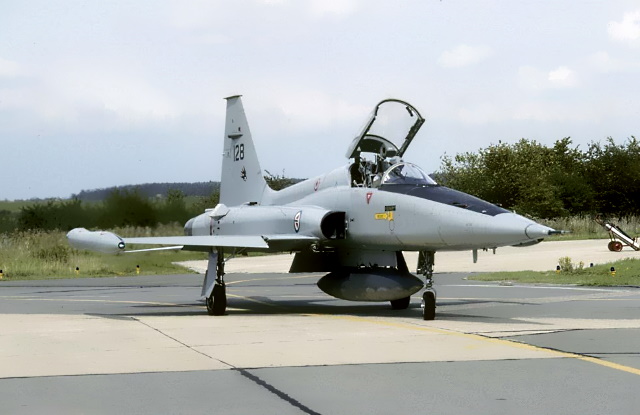 Photo: Archive The Northrop
F-5 Enthusiast
Photo: Archive The Northrop
F-5 Enthusiast
Upgraded Northrop RF-5A 128, 336 Squadron
Seven upgraded Northrop F-5A and eight F-5B remained in use with 336 Squadron at Rygge AB for
some time to come. Three single-seaters (serials 132, 134, 208) received special colours:
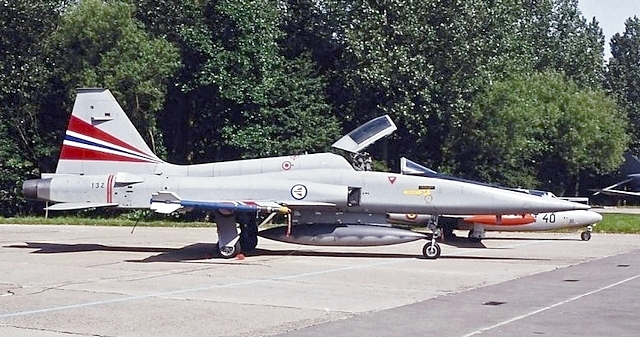
Northrop F-5A Serial 132 with Norwegian flag on tail seen and wings at Leeuwarden AB
(Netherlands) on 02-07-94.
Photo: Archive The Northrop
F-5 Enthusiast
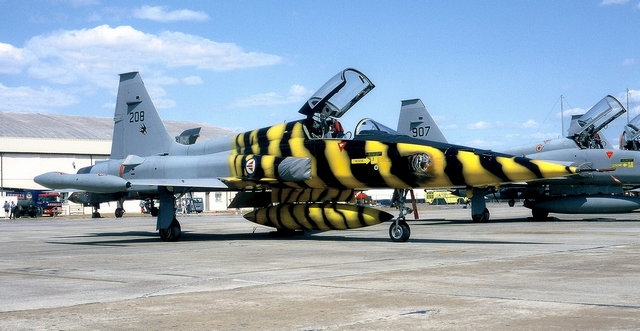
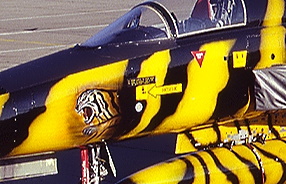
Serial 208 seen in beautiful
"Tiger" colours on 24-07-95 at RAF Fairford.
Tiger painted on nose, serial 208
Photo: Archive The Northrop
F-5 Enthusiast
Their withdrawal came with the official disbandement of
the Squadron (for
financial reasons) on
June 30th 2000, saving around 360m NoK with
the disbandment of the Skvadron itself, personnel reduction of the
Rygge AB and at the Supply Command at Kjeller AB. The last official
flight, a Public Relation
one, was performed by Northrop F-5B serial
908 visiting Sola
AB and Bardufoss AB with
a radio journalist on board.
But the Freedom Fighter was not dead in
Norwegian service! All 15 were kept active, though not all at a time;
they continued (tests had already started in July 1999) supporting development of
the Norwegian anti-ship missile Penguin from Rygge AB, under
the project name "Eye of
the Tiger" (Eot). This started in July 2000,
upon disbandment of the 336 Skvadron.
During "Eot"
flights, missile software and
hardware components were tested on Freedom Fighters equipped with
(among other items) an
especially converted wingtip-mounted fuel-tank containing a
seekerhead of the Penguin flying a simulated missile-mission, a less
expensive
solution than test firing (and destroying) a missile. Tests were
completed by December 2007; the Freedom Fighters were stored and put up
for sale.
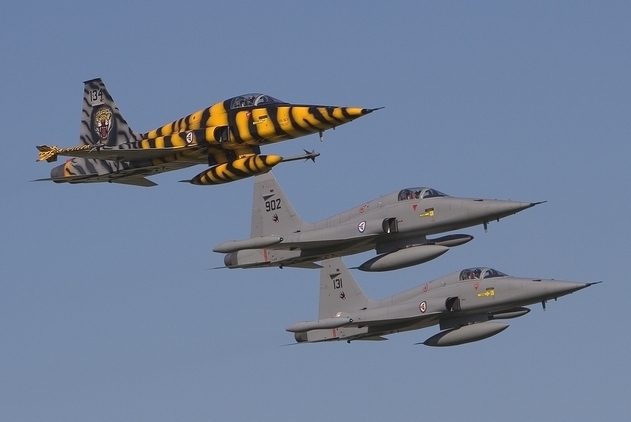
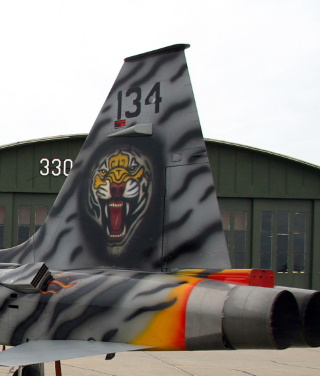
Tiger colours Northrop F-5A serial 134, in company of two
single-seaters utilised by the "Eye
Tail detail of the second tiger coloured aircraft
of the Tiger", overflying Sola AB on 03-06-07, shortly before their
final withdrawal from use.
Photo: Vincent van Ypern
It seems there had been already by 2006
interest in buying these aircrafts by three
tenders, but the end-users were not acceptable for the USA (as country
of origin) or Norway for political reasons.
There was no opposition by Norway in 2008,
when 15 aircrafts were to be bought by a civilian company, Northern General Leasing, to operate an Fighter
Fundamentals Pilot Training program for pilots of
the United Arab Emirates were
to be based at Fort
Worth-Alliance airport (USA), training to be provided by Lockheed
Martin Corp. Unfortunately this had no follow-up, setting the end (at
least for the moment) of the operational career of these aircrafts.
Norwegian based aircrafts were
stored at Rygge AB but they are foreseen to be distributed to several
bases, museums and technical schools. At least two upgraded Northrop
F-5B were shown at the Fort Worth Alliance Air Show in September 2015.
There
are 4 Northrop F-5 at Gardermoen Air Force museum in Bodo, at
least 3 are at Kjevik, 2 in Rygge; approximately 20 are in Norway in
various state of necessary repairs.
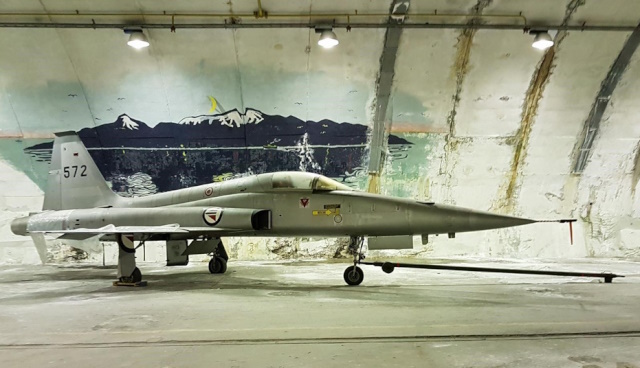 Photo: via Severin Vilum Klever
Photo: via Severin Vilum Klever
Northrop F-5A(G) displayed in caven at Bodo AB (in use only during the Cold War period) seen in 2019


 Photo: unknown
Photo: unknown 
 Photo: Tor Helge Yttervik
Photo: Tor Helge Yttervik Photo: unknown
Photo: unknown 
 Photo: Archive The Northrop
F-5 Enthusiast
Photo: Archive The Northrop
F-5 Enthusiast Photo: Archive The Northrop
F-5 Enthusiast
Photo: Archive The Northrop
F-5 Enthusiast Photo: Archive The Northrop
F-5 Enthusiast
Photo: Archive The Northrop
F-5 Enthusiast




 Photo: via Severin Vilum Klever
Photo: via Severin Vilum Klever